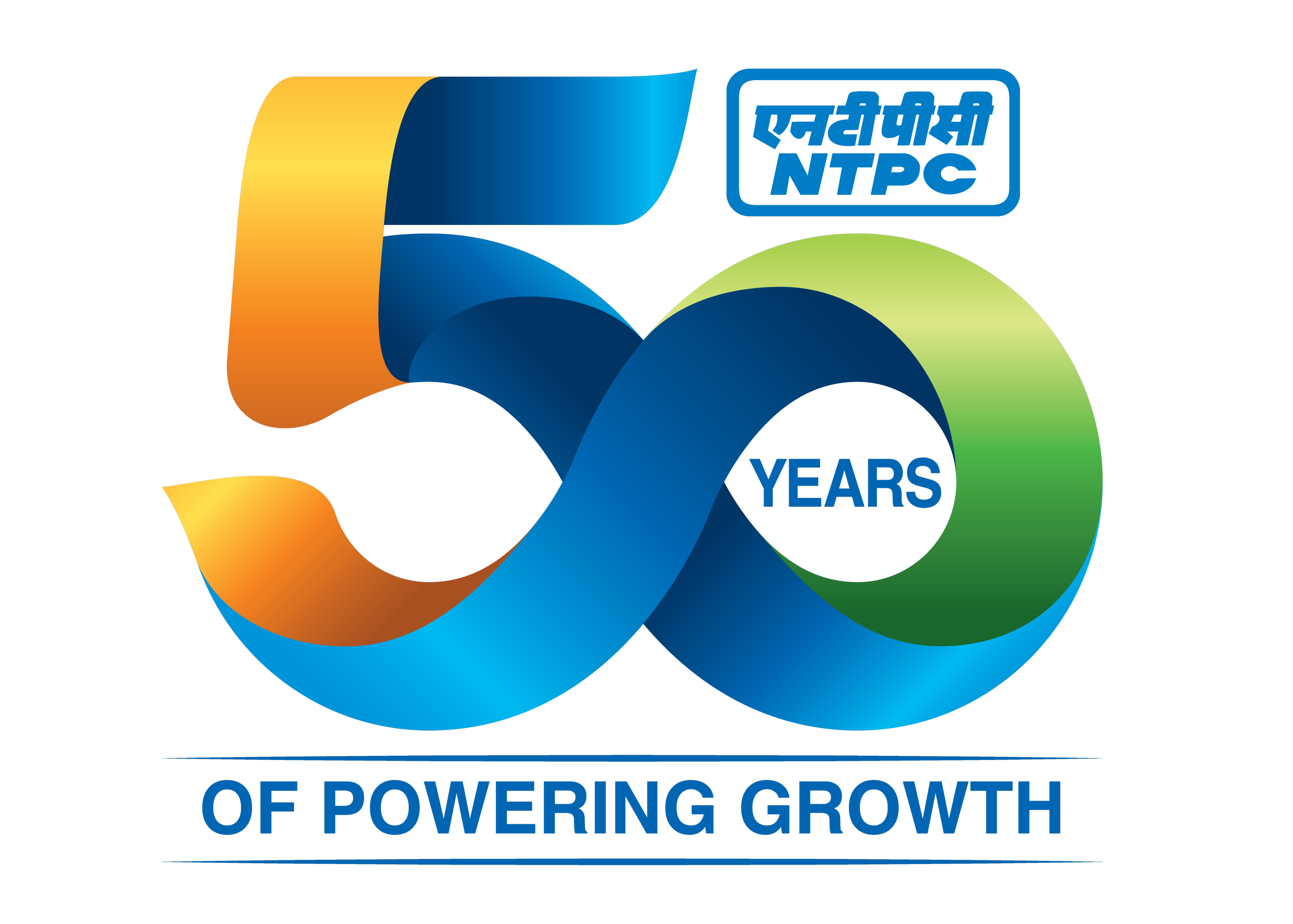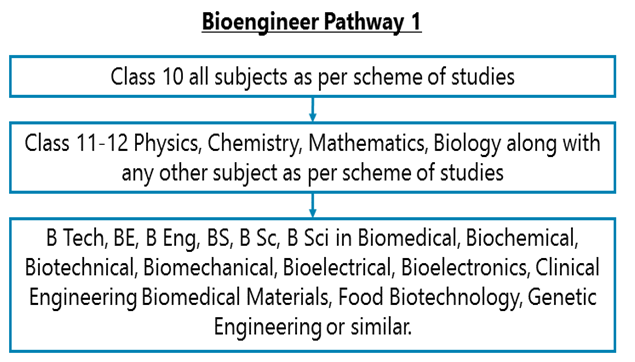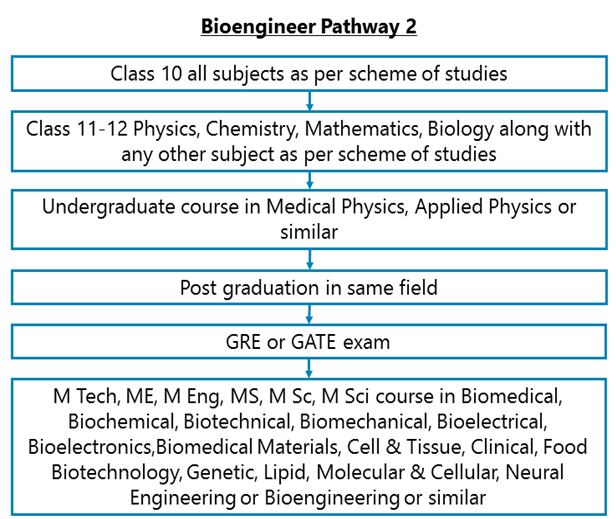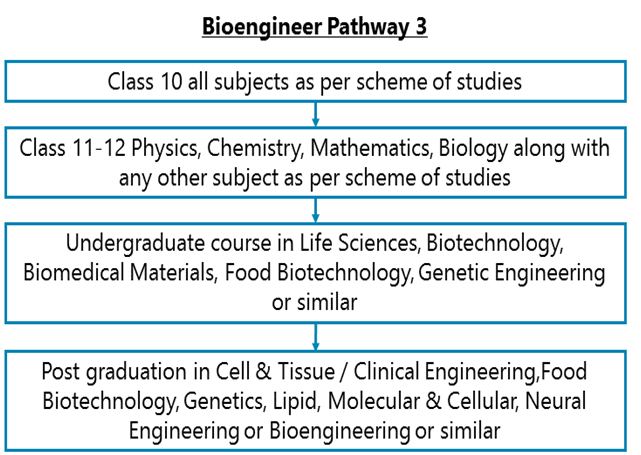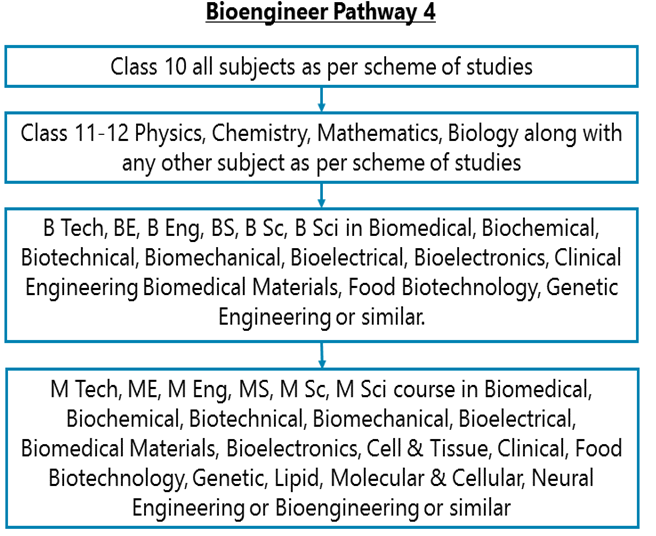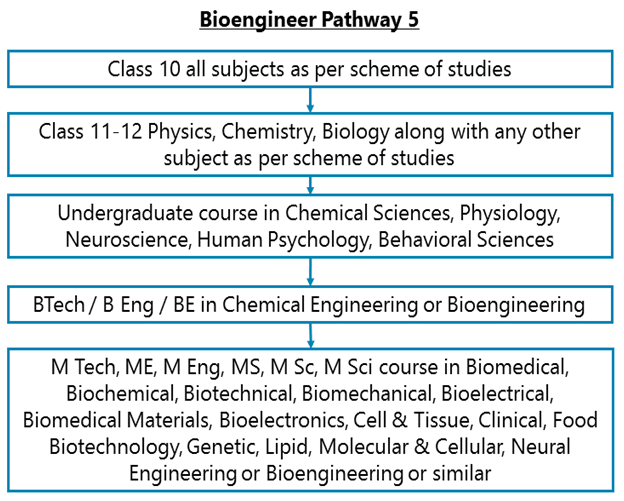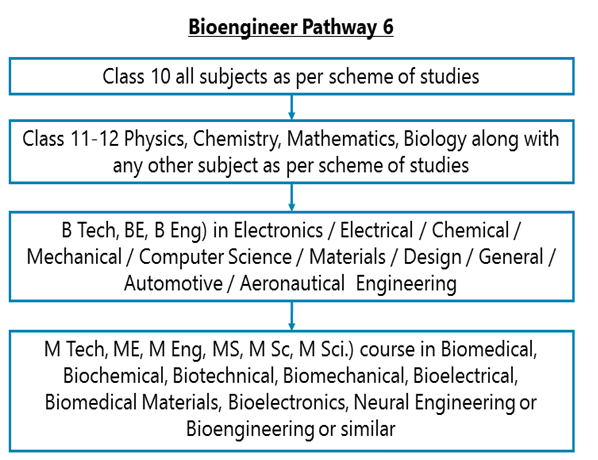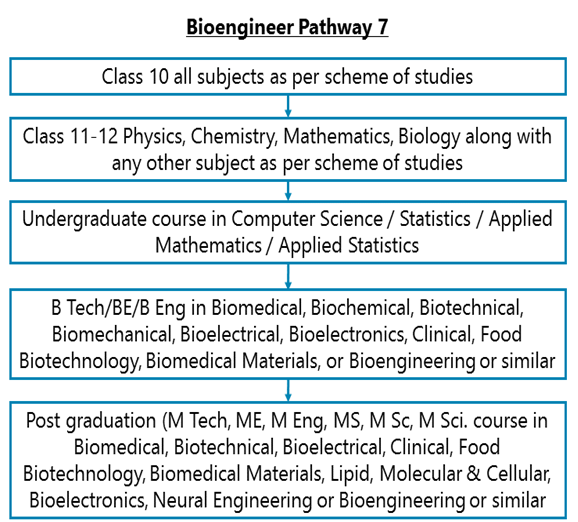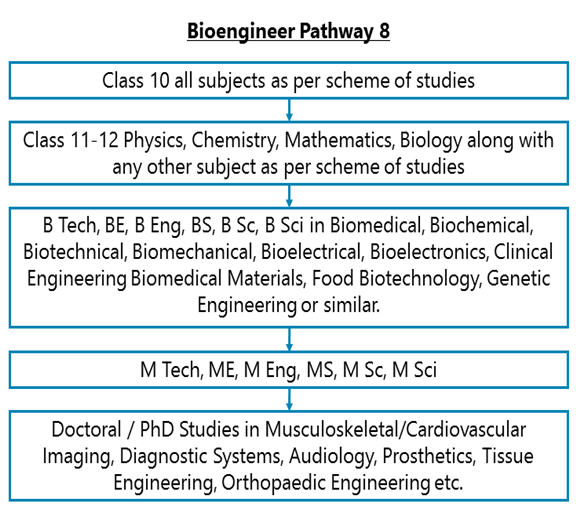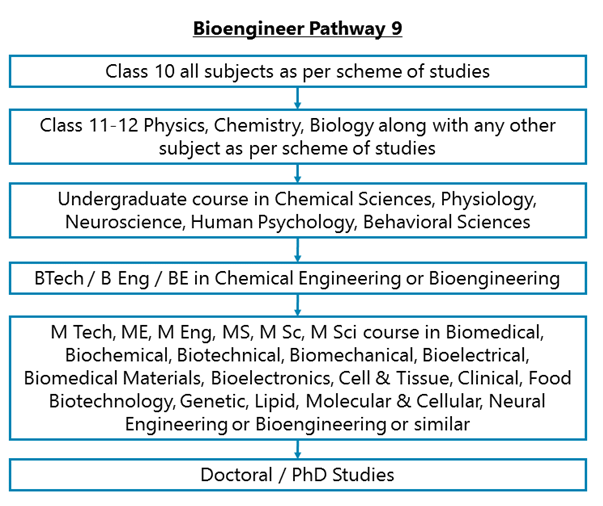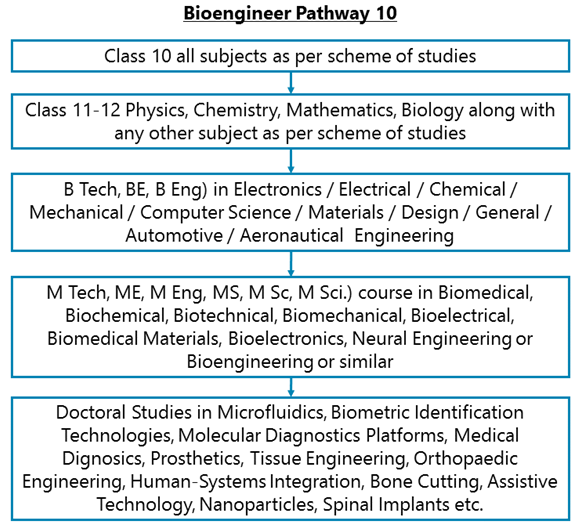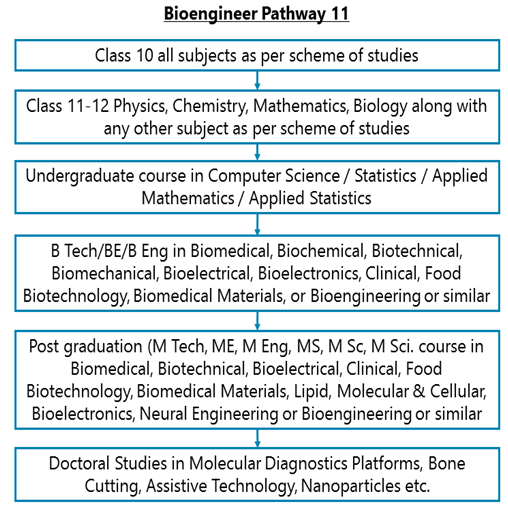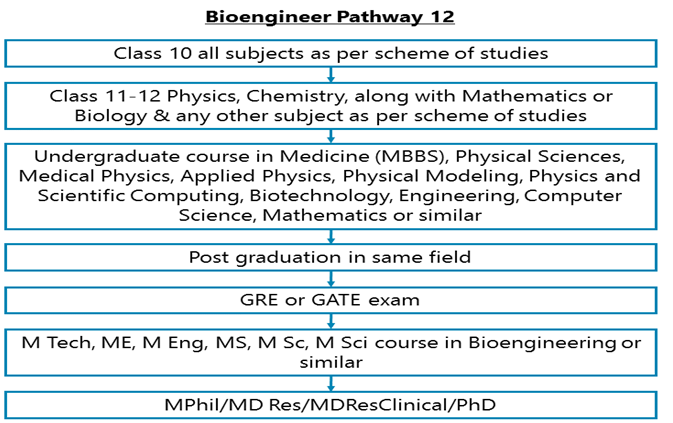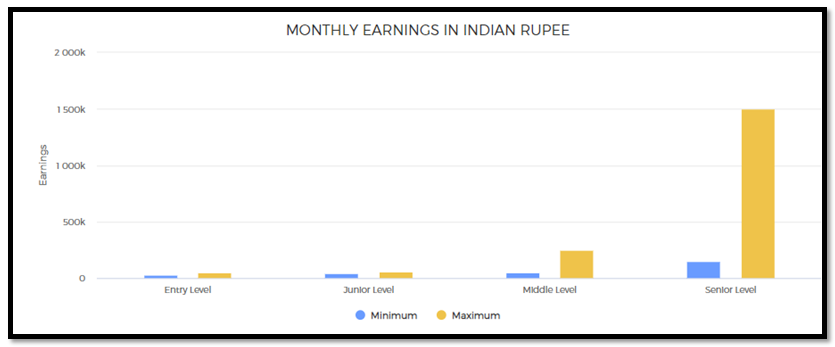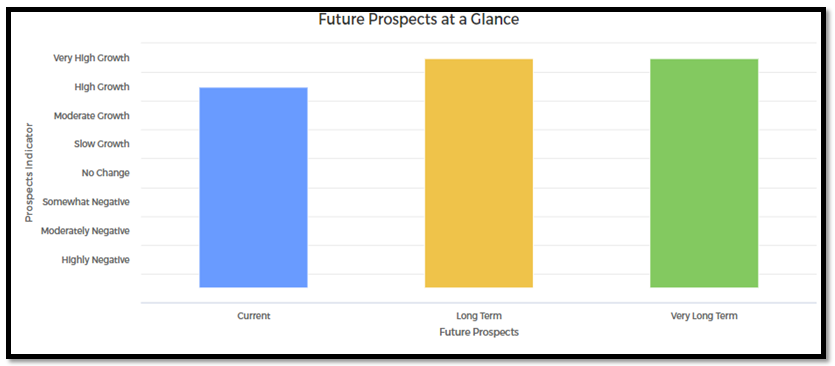Biological Engineer
Entry Level Qualification
12
Career Fields
Engineering & Technology
For Specially Abled







Career Entrance Exam
JEE MAIN BE/BTECH, JEE ADVANCED, GATE, BITSAT UG, VITEEE BE/BTECH
About Career
Bioengineering is one of the fastest growing field of engineering today with an exciting future. Bioengineers use insights of Biology, Engineering, Computational Science, and other fields of Science to ‘engineer’ or design, build, test, and install various products, machines, systems, and applications.
Bioengineers may produce an artificial neural network (network of neurons as in the nervous systems of animals) which mimics an animal’s brain. The artificial neural network may power the artificial intelligence of a robot. Bioengineers may produce bacteria with a specific gene (by altering the natural genetic code of the bacteria) that can be used to mass produce bio-fuels.
Bioengineers may develop artificial animal tissues and ‘bio-print’ the tissues to build an artificial limb or an organ. For example, a bioprosthetic limb (hands or legs) which can be used by persons whose limbs might have to be amputated due to an accident.
Bioengineering may develop nanorobots which can flow through the bloodstream to attack and destroy cancerous cells in human body.
The possibilities are enormous. The future belongs to Bioengineers.
An eagle’s view – few quick examples
Some Bioengineers are trying to develop new robots with a human brain which is a classic example of neuro-engineering and brain-machine interfacing. This requires electronic circuits forming connections like our brains have with nerves: the same kind of networking that works inside our brain. These robots can then be ‘trained’ (or configured) in different specialties like performing medical surgeries on patients or diagnosing diseases.
Hair re-growth is a common concern of people today. Bioengineering also involves developing methodologies to promote new hair growth. Some Bioengineers are trying to develop a collectionoftiny micro-needles (a skin ‘patch’) to be applied to affected areas. These micro-needles are loaded with doses of a molecule ‘UK 5099’ (basically keratin), the protein that makes up hair.This is a new form of bioengineered drug-delivery system.
Then let us come to another interesting case. We typically ‘manually’ apply dyes, or stains, to label tissue samples to identify diseases. The stains highlight color contrasts between healthy tissues and affected ones but the process is time-intensive and expensive as it requires sophisticated laboratory equipment and trained personnel. Bioengineers have developed a way to use ‘computer software’ to digitally and rapidly stain tissue samples. It requires only a standard microscope and laptop computer. This process can also be used by surgeons during a ‘live’ surgery, say if they touch non-cancerous tissue while removing a tumor and need to take a hasty decision.
What will your professional work be like?
As a Bioengineer, you may be performing and executing numerous types of duties and responsibilities depending on which sub-field you are working in. Based on the kind of role you are in, you may be called a Scientist, Engineer or Investigator working with large medical diagnostics laboratories or hospitals / healthcare centers, research centers or biotechnology / pharmaceuticals companies etc.You may be involved in any role related to your educational experience. Apart from the few illustrated current research examples, do check out a few more as well.
Bioengineers can also be ‘Medical Devices Specialists’
In one such kind of role, you may have to review a variety of medical device ‘actions’ which means evaluating performances of medical devices and establishing your inspection reports.
For an example, you may be assisting nurses and technicians to operate a ‘cardiovascular (or heart) monitoring device’ during a patient’s surgery or you might have to check problems in a ‘bone density scanner’ while helping an ‘Orthopedist’ (doctor of bones) with her patient.
Bioengineers can ‘print’ machines too
Let us discuss some other interesting roles that you may work in.
Want to know an exciting fact? Today, as a Bioengineer, you can help patients with disabilities such as loss of limbs or sight, with certain machines that can be printed on a surface? This is ‘Bioprinting’. This is done by printing layers of liquid metal / polymer on a surface and then cooling it to solidify.
Also as Tissue or Gene Engineers
Then you can create synthetic cells / tissues to help patients who are suffering from cell / tissue / organ damage. This is called ‘regenerative medicine’. A tiny group of cells when implanted into a patient can grow into an entire tissue such as ‘muscle’ tissue or even an organ that means the tissue / organ has been regenerated through the ‘synthetic implant’ which is the ‘medicine’ here.
Alternatively, you can be a Bioengineer who engineers human ‘genes’. For an example, you may work trying to ‘repair’ genes causing Epidermolysis Bullosa which is a genetic condition that leads to constant blistering of skin and the skin peeling off all the time, or maybe any other genetic disease.
Maybe make ‘Biosensors’ too? Wait, what is that!
Now arriving at the example of ‘Biosensors’ which are tiny machines containing a biological molecule, let’s say an enzyme or DNA, that can detect chemical changes in its immediate environment suppose when it is put inside a loaf of meat or in waste water. It will be able to detect if there are disease causing pathogens inside the meat or if there is high carbon in the water sample.
Functional Fields of Work
As a Bioengineer, you will be involved in any one of the following broad functional domains and will assume responsibilities accordingly:
1) Research and Development (R&D)
This is laboratory based research, in corporate or academic laboratories, with experimental data or animal models. Researchers typically aim their research projects towards paper publication, sponsorship grant or patent applications. This will essentially include fundamental research (academic research primarily for paper publication), applied research (focused approach and planned outcomes), product / application development (targeted at a specific sector of a certain industry and for commercialization) and translational research (for modifying a laboratory version of a product before industrial high volume manufacture).
2) Education and Training
Typically, in universities, all educators are involved in research – both fundamental and basic as well as applied research. For an example, being an educator you may be working on your research project on how to use artificial neural networks (ANNs-electronic model of human brain) to help car manufacturers predict their future sales and manufacturing volume (how many cars to make in the coming year). Simultaneously, you can be teaching a class of post graduate students as well as supervising 5 different doctoral researches that PhD scholars in your team are completing.
Education here refers to both self-propelled independent research activities in a laboratory setting owned by an academic institution and imparting education / training to students or scholars pursuing higher studies in related disciplines such asBrain Machine Interfaces, Mathematical Methods for Bioengineers, Computational Neuroscience, Molecular and Cellular Biomechanics, Advanced Tissue Engineering etc.
Key Roles and Responsibilities
As a Bioengineer, depending on your functional field of work, you will be engaged with one or moreof the following roles and responsibilities:
For R&D
1. You will be involved in conducting research along with life scientists, chemists, electrical/electronic/mechanical/computer science engineers and medical scientists, on the engineering aspects of biological systems of humans as well as animals.
2. You will be developing mathematical models or computer simulations primarily of human biobehavioral systems for obtaining data to measure or controllife processes.
3. You will be diagnosing and interpreting bioelectric data, using signal processing techniques with the assistance of electrical engineers.
4. You will be innovating experimental solutions to scientific problems through statistical/mathematical modeling using specialized engineering software such as Matlab, LabView, Python, Vicon Workstation, SolidWorks, etc.
5. You will be advising and assisting in the application of instrumentation under clinical environments such as in hospitals, health care centers, or fitness centers.
6. You may be involved in designing and delivering technology for assisting people with disabilities.
7. You will be preparing detailed written or verbal presentations, technical reports and compilations based upon research outcomes for publication, grant or patent applications.
For Education and Training
1. You will be involved in teaching/demonstrating to a class of students or a team of research scholars pursuing this stream of study.
2. You will demonstrate techniques or handling of apparatuses to your students inside a laboratory and counsel / guide students in performance of laboratory course experiments.
3. You will participate in seminars, science congresses, conferences across the world.
4. You will be involved in conducting regular research regarding new technologies, experimental techniques, instruments and laboratory supplies that can improve research standards as well as operating procedures and outcomes.
Career Entry Pathway
Class 10 all subjects as per scheme of studies - Class 11-12 Physics, Chemistry, Mathematics, Biology along with any other subject as per scheme of studies – Undergraduate course in Biomedical, Bioengineering or similar
After completing Class 11-12 Physics, Chemistry, Mathematics, Biology along with any other subject as per scheme of studies, you can go for an undergraduate course (B Tech, BE, B Eng, BS, B Sc, B Sci) in Biomedical, Biochemical, Bio technical, Bio mechanical, Bio electrical, Bio electronics,Clinical, Biomedical Materials, Food Biotechnology, Genetic Engineering or Bio engineering or similar.
Class 10 all subjects as per scheme of studies – Class 11-12 Physics, Chemistry, Mathematics, Biology along with any other subject as per scheme of studies – Undergraduate course in Medical Physics, Applied Physics or similar -Post graduation in same field – GRE or GATE exam – M Tech, ME, M Eng in Bioengineering or similar
After completing Class 11-12 Physics, Chemistry, Mathematics, Biology along with any other subject as per scheme of studies, you can go for an undergraduate course in Physical Sciences, Medical Physics, Applied Physics, Physical Modeling, Physics and Scientific Computing, Biotechnology or similar. You can then complete your post graduation in the same field as your graduation and then appear for GRE / GATE exam. Then you can go for a post graduation (M Tech, ME, M Eng, MS, M Sc, M Sci) course in Biomedical, Biochemical, Biotechnical, Biomechanical, Bioelectrical, Bioelectronics,Biomedical Materials, Cell & Tissue, Clinical, Food Biotechnology, Genetic, Lipid, Molecular & Cellular, Neural Engineering or Bioengineering or similar.
Class 10 all subjects as per scheme of studies – Class 11-12 Physics, Chemistry, Biology along with any other subject as per scheme of studies - Undergraduate course in Life Sciences or similar – Post graduation Cell & Tissue, Clinical, Food Biotechnology
After completing Class 11-12 Physics, Chemistry, Biology along with any other subject as per scheme of studies, you can go for an undergraduate course in Life Sciences, Biotechnology, Biomedical Materials, Food Biotechnology, Genetic Engineering or similar. Then you can go for a post graduation in Cell & Tissue / Clinical Engineering, Food Biotechnology, Genetics, Lipid, Molecular & Cellular, Neural Engineering or Bioengineering or similar.
Class 10 all subjects as per scheme of studies – Class 11-12 Physics, Chemistry, Mathematics, Biology along with any other subject as per scheme of studies – Undergraduate course in Bioengineering – Post graduation in Bioengineering
After completing Class 11-12 Physics, Chemistry, Mathematics, Biology along with any other subject as per scheme of studies, you can go for an undergraduate course in (B Tech, BE, B Eng, BS, B Sc, B Sci) in Biomedical, Biochemical, Biotechnical, Biomechanical, Bioelectrical, Bioelectronics, Biomedical Materials, Clinical, Food Biotechnology, Genetic, Engineering or Bioengineering or similar. Then you can go for a post graduation (M Tech, ME, M Eng, MS, M Sc, M Sci) course in Biomedical, Biochemical, Biotechnical, Biomechanical, Bioelectrical, Biomedical Materials, Bioelectronics, Cell & Tissue, Clinical, Food Biotechnology, Genetic, Lipid, Molecular & Cellular, Neural Engineering or Bioengineering or similar.
Class 10 all subjects as per scheme of studies – Class 11-12 Physics, Chemistry, Mathematics, Biology along with any other subject as per scheme of studies – Undergraduate course in Chemical Sciences, Physiology, Neuroscience – BTech / B Eng / BE in Chemical Engineering or Bioengineering - Post graduation in Bioengineering or similar.
After completing Class 11-12 Physics, Chemistry, Mathematics, Biology along with any other subject as per scheme of studies, you can go for an undergraduate course in Chemical Sciences, Physiology, Neuroscience, Human Psychology, Behavioral Sciences. Then you can follow it up with BTech / B Eng / BE in Chemical Engineering or Bioengineering. Then you can go for a post graduation (M Tech, ME, M Eng, MS, M Sc, M Sci) course in Biomedical, Biochemical, Biotechnical, Biomechanical, Bioelectrical, Biomedical Materials, Bioelectronics, Cell & Tissue, Clinical, Food Biotechnology, Genetic, Lipid, Molecular & Cellular, Neural Engineering or Bioengineering or similar.
Class 10 all subjects as per scheme of studies – Class 11-12 Physics, Chemistry, Mathematics, Biology along with any other subject as per scheme of studies – B Tech, BE, B Eng in Electronics / Electrical / Chemical or similar – Post graduation in Bioengineering or similar
After completing Class 11-12 Physics, Chemistry, Mathematics, Biology along with any other subject as per scheme of studies, you can go for an undergraduate Engineering degree (B Tech, BE, B Eng) in Electronics / Electrical / Chemical / Mechanical / Computer Science / Materials / Design / General / Automotive / Aeronautical Engineering. Then you can go for a post graduation (M Tech, ME, M Eng, MS, M Sc, M Sci.) course in Biomedical, Biochemical, Biotechnical, Biomechanical, Bioelectrical, Biomedical Materials, Bioelectronics, Neural Engineering or Bioengineering or similar.
Class 10 all subjects as per scheme of studies – Class 11-12 Physics, Chemistry, Mathematics, Biology along with any other subject as per scheme of studies – Undergraduate course in Computer Science / Statistics / Applied Mathematics / Applied Statistics -B Tech, BE, B Eng in Bioengineering - Post graduation in Bioengineering or similar
After completing Class 11-12 Physics, Chemistry, Mathematics, Biology along with any other subject as per scheme of studies, you can go for an undergraduate course in Computer Science / Statistics / Applied Mathematics / Applied Statistics. You can follow it up with B Tech/BE/B Eng in Biomedical, Biochemical, Biotechnical, Biomechanical, Bioelectrical, Bioelectronics, Clinical, Food Biotechnology, Biomedical Materials, or Bioengineering or similar. Then you can go for a post graduation (M Tech, ME, M Eng, MS, M Sc, M Sci.) course in Biomedical, Biotechnical, Bioelectrical, Clinical, Food Biotechnology, Biomedical Materials, Lipid, Molecular & Cellular, Bioelectronics, Neural Engineering or Bioengineering or similar.
Class 10 all subjects as per scheme of studies – Class 11-12 Physics, Chemistry, Mathematics, Biology along with any other subject as per scheme of studies - Undergraduate course in Bioengineering – Post graduation in Bioengineering - Doctoral Studies
After completing Class 11-12 Physics, Chemistry, Mathematics, Biology along with any other subject as per scheme of studies, you can go for an undergraduate course in (B Tech, BE, B Eng, BS, B Sc, B Sci) in Biomedical, Biochemical, Biotechnical, Biomechanical, Bioelectrical, Bioelectronics, Biomedical Materials, Clinical, Food Biotechnology, Genetic, Engineering or Bioengineering or similar. Then you can go for a post graduation (M Tech, ME, M Eng, MS, M Sc, M Sci) course in Biomedical, Biochemical, Biotechnical, Biomechanical, Bioelectrical, Bioelectronics, Biomedical Materials, Cell & Tissue, Clinical, Food Biotechnology, Genetic, Lipid, Molecular & Cellular, Neural Engineering or Bioengineering or similar. Then you can go for Doctoral Studies in Musculoskeletal/Cardiovascular Imaging, Diagnostic Systems, Audiology, Prosthetics, Tissue Engineering, Orthopaedic Engineering etc.
Class 10 all subjects as per scheme of studies – Class 11-12 Physics, Chemistry, Mathematics, Biology along with any other subject as per scheme of studies – Undergraduate course in Chemical Sciences, Physiology, Neuroscience – BTech / B Eng / BE in Chemical Engineering or Bioengineering - Post graduation in Bioengineering or similar – Doctoral Studies
After completing Class 11-12 Physics, Chemistry, Mathematics, Biology along with any other subject as per scheme of studies, you can go for an undergraduate course in Chemical Sciences, Physiology, Neuroscience, Human Psychology, Behavioral Sciences. Then you can follow it up with BTech / B Eng / BE in Chemical Engineering or Bioengineering. Then you can go for a post graduation (M Tech, ME, M Eng, MS, M Sc, M Sci) course in Biomedical, Biochemical, Biotechnical, Biomechanical, Bioelectrical, Bioelectronics, Biomedical Materials, Cell & Tissue, Clinical, Food Biotechnology, Genetic, Lipid, Molecular & Cellular, Neural Engineering or Bioengineering or similar. Then you can complete your Doctoral Studies in Medical Diagnostics, Prosthetics, Tissue Engineering, Orthopaedic Engineering, Human-Systems Integration, Bone Cutting, Assistive Technology, Nanoparticles, Spinal Implants, Biometric Identification Technologies, Molecular Diagnostics Platforms etc.
Class 10 all subjects as per scheme of studies – Class 11-12 Physics, Chemistry, Mathematics, Biology along with any other subject as per scheme of studies – B Tech, BE, B Eng in Electronics / Electrical / Chemical or similar – Post graduation in Bioengineering - Doctoral Studies
After completing Class 11-12 Physics, Chemistry, Mathematics, Biology along with any other subject as per scheme of studies, you can go for an undergraduate Engineering degree (B Tech, BE, B Eng) in Electronics / Electrical / Chemical / Mechanical / Computer Science / Materials / Design / General / Automotive / Aeronautical Engineering. Then you can go for a post graduation (M Tech, ME, M Eng, MS, M Sc, M Sci.) course in Biomedical, Biochemical, Biotechnical, Biomechanical, Bioelectrical, Biomedical Materials, Bioelectronics, Neural Engineering or Bioengineering or similar. Then you can complete your Doctoral Studies in Microfluidics, Identification Technologies, Molecular Diagnostics Platforms, Medical Dignostics, Prosthetics, Tissue Engineering, Orthopaedic Engineering, Human-Systems Integration, Bone Cutting, Assistive Technology, Nanoparticles, Spinal Implants etc.
Class 10 all subjects as per scheme of studies – Class 11-12 Physics, Chemistry, Mathematics, Biology along with any other subject as per scheme of studies – Undergraduate course in Computer Science / Statistics / Applied Mathematics / Applied Statistics - B Tech, BE, B Eng in Bioengineering - Post graduation in Bioengineering or similar- Doctoral Studies
After completing Class 11-12 Physics, Chemistry, Mathematics, Biology along with any other subject as per scheme of studies, you can go for an undergraduate course in Computer Science / Statistics / Applied Mathematics / Applied Statistics. You can follow it up with B Tech/BE/B Eng in Biomedical, Biochemical, Biotechnical, Biomechanical, Bioelectrical, Bioelectronics, Clinical, Food Biotechnology, Lipid, Molecular & Cellular, Neural Engineering or Bioengineering or similar. Then you can go for a post graduation (M Tech, ME, M Eng, MS, M Sc, M Sci.) course in Biomedical, Biotechnical, Bioelectrical, Clinical, Biomedical Materials, Food Biotechnology, Lipid, Molecular & Cellular, Bioelectronics, Neural Engineering or Bioengineering or similar. Then you can complete your Doctoral Studies in Molecular Diagnostics Platforms, Bone Cutting, Assistive Technology, Nanoparticles, Microfluidics, Musculoskeletal/ Cardiovascular Imaging, Tissue Engineering, Genetic Engineering, Audiology etc.
Class 10 all subjects as per scheme of studies – Class 11-12 Physics, Chemistry, Mathematics, Biology along with any other subject as per scheme of studies – Undergraduate course in Medicine, Medical Physics, Applied Physics or similar – GRE or GATE Exam - Post graduation in Bioengineering or similar – MPhil in ‘Biomedical Engineering & Imaging Sciences’
After completing Class 11-12 Physics, Chemistry, Mathematics, Biology along with any other subject as per scheme of studies, you can go for an undergraduate course in Medicine (MBBS), Physical Sciences, Medical Physics, Applied Physics, Physical Modeling, Physics and Scientific Computing, Biotechnology, Engineering, Computer Science, Mathematics or similar. You can then complete your post graduation in the same field as your graduation and then appear for GRE / GATE exam. Then you can go for a post graduation (M Tech, ME, M Eng, MS, M Sc, M Sci) course in Biomedical, Biochemical, Bio-technical, Bio-mechanical, Bio-electrical, Biomedical Materials, Bio-electronics, Cell, Tissue, Clinical, Food Biotechnology, Genetic, Lipid, Molecular & Cellular, Neural Engineering or Bio-engineering or similar. Then you can complete your M Phil/MD Res/MDResClinical/PhD in Medical Physics and Bio-engineering, Biomedical Engineering & Imaging Sciences, Biomedical optics, Radiation physics, Continence and skin technology, Magnetic resonance imaging and spectroscopy, Cardiovascular Imaging, Surgical; Intervention Engineering, Human-Systems Integration, Bone Cutting, Assistive Technology, Medical Diagnostics, Prosthetic, Tissue Engineering, Orthopedic Engineering, Nano-particles, Spinal Implants, Biometric Identification Technologies, Molecular Diagnostics Platforms etc.
Required Qualification & Competencies
After your Class 11-12 with Physics, Chemistry, Mathematics & Biology and any other subjects as per scheme of studies, you can study for an undergraduate degree. Then you can do a Master’s degree. Then you may either opt for a work opportunity or complete your Ph.D.
You can study for a Bachelor’s / Master’s / Doctoral degree in any of the following fields (Note that all these fields may not offer you a degree at all three levels, that is in Bachelor’s, Master’s and Doctoral. Some fields may offer a degree only at the Master’s or at the Doctoral level or may only be a specialization / certificate program):
1. Biomedical Engineering
2. Biomechanical Engineering
3. Bioprocess Technologies
4. Biosensor Technologies
5. Cell & Tissue Engineering
6. Biochemical Engineering
7. Biochemical Engineering & Biotechnology
8. Bioelectrical Engineering
9. Bioelectronics Engineering
10. Bioengineering
11. Bioinformatics (Engineering)
12. Biotechnology (Engineering)
13. Clinical Engineering
14. Food Biotechnology (Engineering)
15. Food Processing Technologies
16. Food Technology
17. Genetic Engineering
18. Lipid Engineering
19. Molecular & Cellular Engineering
20. Neural Engineering
21. Rehabilitation Technologies
22. Sugar Processing Technology
23. Biomedical Imaging
24. Systems Physiology
25. Neurotechnologies/Neural Engineering
26. Nanobiotechnology
27. Orthopaedic Biomechanics
28. Human Neuromechanical Control and Learning
29. Molecular Cellular and Tissue Biomechanics
30. Physiological Fluid Mechanics
31. Advanced Tissue Engineering
32. Cellular and Molecular Mechanotransduction
33. Biomimetics
34. Advanced Physiological Monitoring and Data Analysis
35. Brain Machine Interfaces
36. Computational Neuroscience
37. Animal Locomotion and Bioinspired Robotics
38. Biomechanics
39. Mechanobiology
MINIMUM EDUCATION REQUIRED | MAXIMUM EDUCATION REQUIRED |
Under Graduate | Post-Doctoral |
COMPETENCIES REQUIRED
1. You should have interests for Investigative Occupations. Investigative occupations involve working with ideas and quite a lot of thinking, often abstract or conceptual thinking. These involve learning about facts and figures; involve use of data analysis, assessment of situations, decision making and problem solving.
2. You should have interests for Realistic Occupations. Realistic occupations involve more practical and hands-on activities than paperwork or office work. Realistic occupations often involve physical activities for getting things done using various tools and equipment.
3. You should have interests for Enterprising Occupations. You should have interests for Enterprising Occupations. Enterprising occupations involve taking initiatives, initiating actions, and planning to achieve goals, often business goals. These involve gathering resources and leading people to get things done. These require decision making, risk taking and action orientation.
4. You may need knowledge of Biological Sciences - Knowledge of plants and animals, their anatomical structure, cell structure, tissues, physiological functions, evolution, and all other related aspects.
5. You should have knowledge ofEngineering and Technology - Knowledge of various applications of one or more branches of Engineering Science & Technology to manufacture and produce various goods. This includes knowledge about design, development, prototype testing, manufacturing, construction, installation, repair and maintenance.
6. You should have knowledge of using specialized engineering software such as Matlab, LabView, Python, Vicon Workstation, SolidWorks, etc.
7. You should have knowledge of Technical and Engineering Design - Knowledge of various techniques, methods, specifications and tools for creating, developing and laying out designs of various machines, equipment, devices, structures, systems and processes. This includes developing blueprints, drawing and models.
8. You may need knowledge of Healthcare Science and Services - Knowledge of different fields which are related to offering various types of healthcare services to people; assisting physicians and surgeons to carry out diagnosis, treatment and prevention of human diseases, ailment and disorders.
9. You should have Critical Thinking skills- Skills in the analysis of complex situations, using logic and reasoning to understand the situations and take appropriate actions or make interpretations and inferences.
10. You should have Reading Comprehension Skills - Skills in understanding written sentences and paragraphs in work related documents.
11. You should have Judgment and Decision Making Skills - considering pros and cons of various decision alternatives; considering costs and benefits; taking appropriate and suitable decisions.
12. You should have Problem Solving Skills - Skills in analysis and understanding of problems, evaluating various options to solve the problems and using the best option to solve the problems.
13. You should have Oral Comprehension Ability - listen to and understand information and ideas presented through spoken words and sentences.
14. You should have Oral Expression Ability - communicate information and ideas in speaking so others will understand.
15. You should have Deductive Reasoning Ability - apply general rules and common logic to specific problems to produce answers that are logical and make sense. For example, understanding the reasons behind an event or a situation using general rules and common logic.
16. You should have Problem Sensitivity - The ability to tell when something is wrong or is likely to go wrong. It does not involve solving the problem, only recognizing there is a problem.
17. You should have Inductive Reasoning Ability - The ability to combine pieces of information from various sources, concepts, and theories to form general rules or conclusions. For example, analysing various events or situations to come out with a set of rules or conclusions.
18. You should have Near Vision - The ability to see details at close range (within a few feet of the observer).
19. You are always or mostly careful about your actions and behaviour.
20. You are always or mostly disciplined in your action and behaviour.
21. You are always calm or generally remain calm in most situations.
22. You can always act independently or could do so in most situations.
23. You always prefer to experience newthings and have new experiences or you mostly do.
Career - Job Opportunities & Profiles
Biological engineers can be employed by companies working in the design, development and manufacture of medical devices; in hospitals to collaborate with clinicians in offering non-clinical services; in research institutes or Academia like universities such as various IITs pan India; in governmental regulatory agencies; pharmaceuticals/biopharma industry, cell/gene/tissue engineering sectors, fitness equipment industry, bioelectronics (such as sensors) industry, defense related research centers; or as technical consultants within marketing departments.
There are many areas of employment that will open up to you in:
1. Healthcare, Fitness and Wellness
2. Medical device industry
3. Research in instrumentation, genetic/cell/tissue engineering, bioelectronics, biopharma, regenerative/precision medicine etc.
4. Start-ups in fields like diagnostics instruments, biotechnology, pharmaceuticals/biopharmaceuticals, fitness equipment, genetics, nanotechnology, neural technology or any other innovative businesses relating to the various sub-disciplines of Engineering Life-Sciences
5. Teaching
6. Consultancy
You can find work in medical diagnostics laboratories, electronics/mechanical industry, hospitals and health centers, biotechnology companies, ambulatory care technology, pharmaceutical/therapeutics companies or allied companies, clinical testing laboratories, academic &government research institutes etc.
Some of the leading global companies that you may work with include Procter and Gamble, Johnson & Johnson Family of Companies, Boston Scientific Corporation, Microsoft Corporation, Oracle Corporation, Abbott Laboratories, Apple Inc., Google Technologies, Intel Corporation, Honeywell International Inc., Texas Instruments etc.
Some key recruiters in India include TATA Elxsi, Fortis Hospitals, Baxter, Medtronic, M P Birla Foundation, Medica Hospitals Private Limited, Metro Group of Industries, Apollo Home Healthcare Limited, Cognizant Technology Solutions etc.
Some of the entry – level work roles that you may get in such organizations are:
1. Research Biomedical Engineer
2. Biomedical Application Engineer
3. Biomedical Integration Engineer
4. Biomedical Research Scientist
5. Biomedical Studies Engineer
6. Research & Development Engineer
7. Research & Development Scientist
8. Research Engineer Intern (Biomedical)
9. Sensors Engineer Intern (Advanced R&D)
10. Coordinating Biomechanical Engineer
11. Neural Engineer
12. Demonstrator
13. Graduate Teaching Assistant
SPECIALISATION TRACKS IN THIS CAREER
1. Bioengineer (Neuro-Engineering)
The primary objective of Neuro-Engineers is to imitate and simulate human brain functions in electronic devices, super computers, robots, etc. through Artificial Intelligence. 2 main things that they try to copy is ‘learning from experience’ and ‘discovering new knowledge’. For example, a child can tell the difference between a tree, a cat and a car whereas a machine can juggle millions of data at lightning speeds but cannot do this simple task of identifying a tree/car/cat or even distinguish between fire and water. This is what Neural Engineers all over the world are trying to develop today: make machines capable of simple tasks that are very easy for a human brain.
2. Clinical Engineer
Clinical Engineers work in a clinical environment (hospitals, healthcare centers, nursing homes, etc.) for effective clinical equipment management. They have to review past performances of various equipment/ devices used at these places; evaluate them from an engineering perspective and recommends new equipment for procurement if required. They also work with the nursing staff to assist/train them to reduce equipment use errors and for improving equipment features utilization (how effectively a device can be used). Clinical engineers may also advise medical device producers/manufacturers regarding prospective improvements that can be added to the design based on other personal clinical experiences.
3. Bioengineer (Biosensors)
Biomedical sensors / Biosensors / Molecular Sensors are electrochemical tools containing a biological element / molecule may be an enzyme, a biochemical, or DNA which can detect specific biological, chemical or physical processes and then transmit or report this data through display systems or some sort of measuring technique. 3 types of applications are there for Biosensors in today’s market: Diagnostic, Medical Imaging and Monitoring (for example wearable medical devices like FitBit®). Let us check a few examples. Glucose monitor, used regularly by diabetic individuals to check blood sugar level, has biosensors in it. Biosensors are also used in the food industry such as to detect pathogens in fresh meat, poultry or fish. Then another fine example would be the use of biosensors to detect presence of toxic gases inside a coal mine.
4. Forensic Biomechanical Engineer
Forensic Biomechanical Engineers, as the name suggests, works in crime detection scenarios with a multi-disciplinary team of engineers and scientists for ‘reconstructing incidents’ that may have caused some kind of physical impact / injury to people involved in a criminal investigation case. They have to conduct field investigations to gather information about vehicle crashes, falls, accidents, etc. Professionals in this field are typically Ph.D. holders.
5. Bioengineer (Molecular / Cellular / Tissue Therapeutics)
‘Cell therapy’ is the utilization of living cells for treating or curing human diseases or injuries. Tissue engineering (TE) is focused on restoring, maintaining, improving, or replacing damaged tissues / organs. This involves using synthetically built tissues/cell masses to cure human deficiencies of various kinds or tissue damages resulting from a disease, supplement the immune system, rewrite DNA sequences or even repair brain damage. These synthetic forms of cells are usually stored cryogenically (storing at freezing low temperatures). An example from blood tissue engineering will be awesome here. ‘Respirocyte’, an artificial red blood cell (RBC), proposed by Robert Freitas is an active pumping vessel which is able to deliver 236 times more oxygen than natural RBCs. Respirocytes can be externally controlled with a remote and has a computing system and numerous pressure/chemical sensors.
6. Bioengineer (Nanobiotechnology)
A nanometer is one billionth of a meter. Means it is 1/1,000,000,000 or 0.000000001 meter and Nanobiotechnology deals with such small particles. Nanobiotechnology is increasingly being applied in fields like medicine & healthcare, agriculture, electronics, etc. Right from nanorobots which could go inside a human organ to repair a diseased part to nanoparticles used for building wearable computers – Nanobiotechnology can be applied in many fields.
7. Bioengineer (Bioprinting)
3D medical printing technology is the most innovative out of all the emerging fields. You have usually seen a 2-dimensional picture / text being printed. Did you ever imagine that you can ‘print’ an entire machine on a surface, such as an artificial ear? It is also known as ‘Additive Manufacturing’. This technology allows us to print layer after layer to slowly create a three-dimensional object. Then the layers are allowed to cool and solidify as they are liquid when they come out of the printer. You must know about this teenager from the UK who received the first prosthetic hands in 2016 which was produced through additive manufacturing technology meaning it was printed! She had lost both her hands to septicemia and had to be amputated.
8. Genetic Engineer
Genetic Engineers work on DNA / RNA, the building materials of all living organisms including bacteria/viruses. Genes are made up of DNA/RNA (in viruses). They may have to cut, attach, create, fix, modify, repair segments of DNA or RNA trying to achieve planned results. They may be involved in genetic analyses of various cell types or studying family histories of consecutive generations or analyze genes in biological samples of human patients or trying to discover a drug for a particular genetic disease.
9. Bioengineer (Bionics, Biomechanics and Mechanobiology)
The most complex macromolecular machines are found within cells. This field deals with biological machines that have ‘moving’ parts. Have you heard of molecular car or nanocar? They were actually developed in the US artificially in 2005 with an H-shape body with 4 identical molecules on 4 corners as wheels. Then think of ‘Bionic Eyes’ or prosthetic eyes that help people overcome blindness or defective vision. Then we also have ‘climbing robots’ that are inspired by the geckos (lizard like animal). This specialized field is all about creating electromechanical machines taking clues or hints from nature.
10. Bioengineer (Ergonomics, Kinesiology and Industrial Design)
Ergonomists or Kinesiologists apply their theoretical backed by practical knowledge for optimizing the interactions between humans and their environments and the systems that we engage. As examples, you can consider the ergonomic design of aircraft/spacecraft seating structures or furniture design or say common human facing household products such as ordinary spin mops or maybe specialized mining instruments. These are ergonomically designed to prevent all ergonomic hazards caused to the musculoskeletal system due to repetitive movement, manual handling, workplace/job/task design, and poor body positioning, etc.
CAREER GROWTH
You may grow though the following roles depending on your functional field of work.
Research:
Postdoctoral Research Engineer, Senior Engineering Associate, Principal Engineer, Senior Research Investigator, Division Leader, Vice President of Research Administration and Innovation, Associate Director-R&D Engineering, Director-R&D (Sustaining and Engineering)
Education:
Visiting Associate Scientist, Associate Lecturer, Lecturer (Level B), Lecturer (Level C), Senior Lecturer/Associate Professor, Emeritus Professor, Visiting Senior Research Fellow, Honorary Senior Research Fellow, Director of Department.
Salary Offered
1. At the entry level jobs, after your Master’s degree depending upon the institution where you are graduating from, you may expect to get about Rs. 30,000 – 50,000 or even more a month. In junior level jobs (after 4-5 years of experience), you can make about Rs. 45,000 – 60,000 or more per month.
2. In mid-level engineering jobs in India (after having 8-10 years of experience), you can expect to earn about Rs. 50,000 – 2,50,000 or even more a month.
3. In senior-level engineering jobs in India (after having 15 years of experience), you can expect to earn about Rs. 1,50,000 – 15,00,000 or even more a month.
Global (US)
1. Most importantly, to practice or be recruited as an Engineer (from any discipline) in the US, you will have to mandatorily pass the Fundamentals of Engineering (FE) examination or equivalent examinations conducted by engineering licensure boards required for professional registration in the various states of the US, the District of Columbia, Guam, and Puerto Rico.
2. Remember that, if you are not a US citizen, getting a job in USA after a bachelor’s degree will be a rare case. However, after your Graduate (Master’s or Ph.D.), you may look forward to if you do really well in your course. The chances of getting a job after graduate courses increase with the reputation of the university from where you graduate. However, if you are from a premier institute like IIT, you may get a campus placement in USA. But even that is few and far between.
3. At the entry level jobs, after your Bachelor’s degree depending upon the institution where you are graduating from, you may expect to get about USD 3,000 – 6,000 or even more a month.
After 4-5 years of work experience, you may expect to earn around USD 4,500 to USD 8,000 a month or more depending on your job location and roles.
4. At the entry level jobs, after your Graduate (after Master’s or Ph.D.) degree depending upon the institution where you are graduating from, you may expect to get about USD 4,500 – 7,500 or even more a month.
At the entry level after a Master degree, even a part time Medical Device Evaluation Engineer may get USD 57,015 - USD 88,450 a year or more.
5. In junior level jobs (after 4-5 years of postgraduation), you can make about USD 5,000 – 8,000 or more per month.
In mid-level jobs (after having 8-10 years of experience), you can expect to earn about USD7,000 – 12,500 or even more a month.
MONTHLY EARNINGS IN INDIAN RUPEE
1. Entry level: 0 - 2 years of work experience
2. Junior Level: From 1 to 12 years of work experience
3. Mid Level: From 5 to 20+ years of work experience
4. Senior Level: From 10 to 25+ years of work experience (there could be exceptions in some high-end technical, financial, engineering, creative, management, sports, and other careers; also in the near future, people will reach these levels much faster in many careers and in some careers, these levels will have no meaning as those careers will be completely tech skill driven such as even now, there is almost no level in a Cyber Security Expert’s job).
Work Activities
1. Analysing and interpreting data and information - Analysis of data and information to find facts, trends, reasons behind situations, etc.; interpretation of data to aid in decision making.
2. Inspecting equipment, systems, structures, and materials - Inspecting equipment, systems, structures, and materials to ascertain quality, performance, defects, causes of errors, etc.
3. Drawing, drafting, laying out and specifying objects, equipment, devices, tools, and systems - Creating and developing designs, drawings, layouts and specifications about how to construct, manufacture, assemble, build, use, and maintain various equipment, devices, tools and systems.
4. Fabricating, assembling, and constructing equipment, devices and products - Fabricating, assembling, constructing or otherwise manufacturing products, equipment, devices and tools; testing and calibrating products, equipment, devices, tools and systems.
5. Identifying objects, actions, and events - Identifying various characteristics of objects; observing and understanding actions and events; understanding changes in actions and events.
6. Creative thinking - Developing new ideas, concepts, innovative solutions to problems, newer ways of getting things done, designing products and services, creating work of art and craft, etc.
7. Operating machines, equipment, devices, systems and processes - Using various methods and techniques to operate machines, equipment, devices, systems and processes in industrial and other settings.
8. Strategic planning - Developing visions and goals, developing strategies and action plans for achieving visions and goals.
9. Updating and using relevant knowledge - Keeping updated with the latest knowledge relevant to your fields of work and use of the relevant knowledge in getting things done.
10. Getting Information and learning - Observing, hearing, reading, using computers, or otherwise obtaining information and learning from it.
11. Monitoring processes, systems and performance - Observing and recording information on various criteria to monitor mechanical, electronic, electrical and other processes and systems; monitoring progress of projects and tasks.
12. Making decisions and solving problems - Analysis of data and information; evaluation of alternative decisions and results of decisions; taking the right decisions and solving problems.
13. Organising, planning and prioritising tasks - Planning and organising tasks in order to achieve work goals; prioritising tasks to achieve goals and making the best use of the time available.
14. Using computers for work - Using computers for day-to-day office work; using computer software for various applications in day-to-day professional work; entering data and process information; for writing.
15. Working in a team - Working in a team of people; developing team; maintaining professional relationships among team members.
Future Prospects
You can expect a bright future in this field as the industry growth prospects are encouraging.This is an enormous industry registering an amazing growth for the past few years.
The Global Biomedical Metal Market is poised to grow at a rate of around 7.8% compounded annually over the next decade to reach approximately $34.91 billion by 2025.The Neural Network Software market worldwide is projected to grow by US$ 75.5 billion, driven by a compounded growth rate of 32.4%.
The Global Temperature Sensors market accounted for $5.60 billion in 2017 and is expected to reach $10.10 billion by 2026 growing at a rate of 6.8% compounded annually during 2017-2026.
The Global Biomedical Sensor market was valued at US$ 9.554 billion in 2017 and is projected to expand at a rate of 3.75% compounded annually to reach US$11.912 billion by 2023.
The Global Regenerative Medicine Market (including cell and tissue/molecular/genetic engineering) was worth $28 billion in 2018 and will grow to over $81 billion by 2023, with a rate of 23.3% compounded annually.
The Global Orthopedic Prosthetics market accounted for $1,597.10 million in 2017 and is expected to reach $2,911.60 million by 2026 growing at a rate of 6.9% during 2017-2026.
FUTURE PROSPECTS AT A GLANCE

